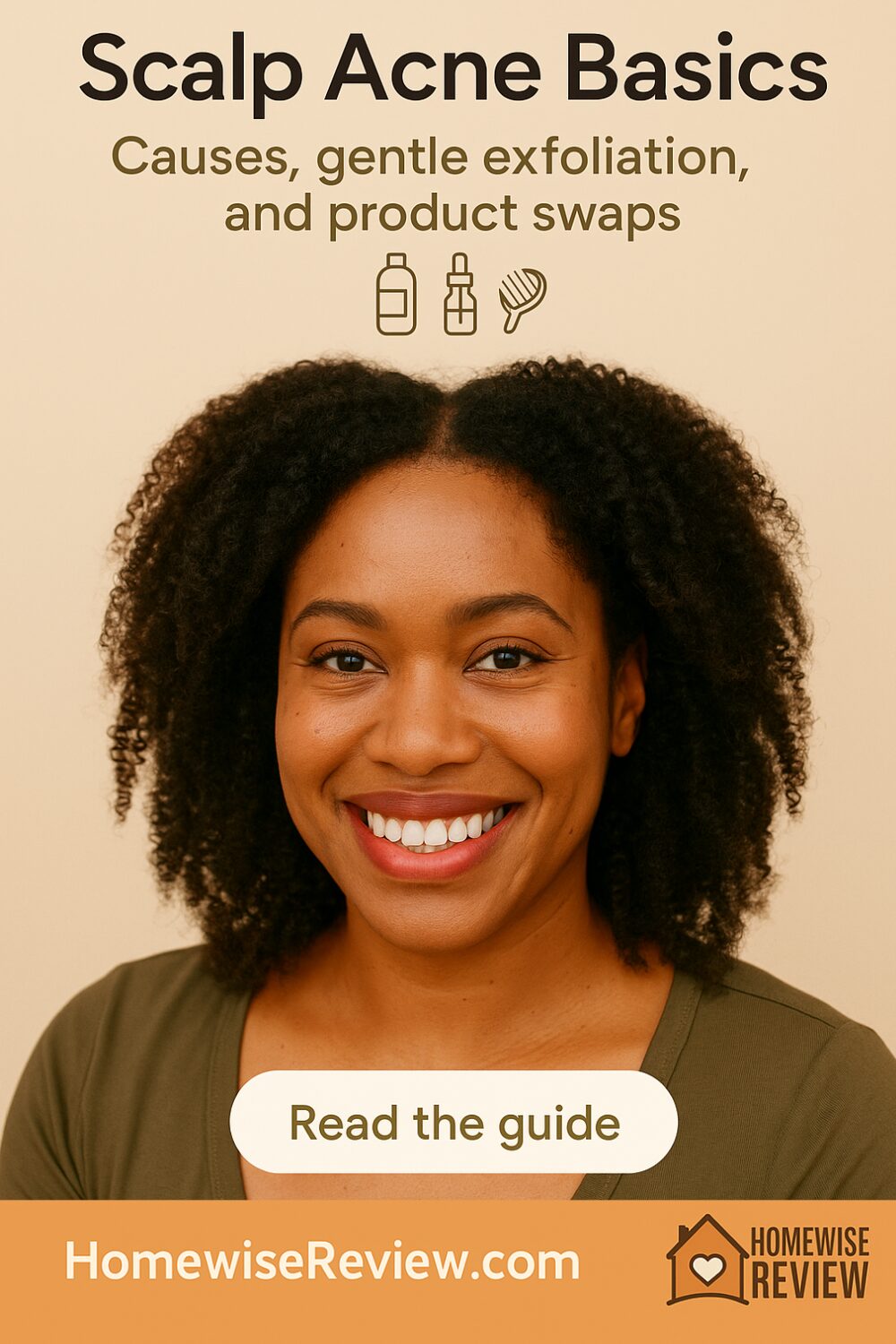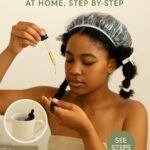
Who this is for: Anyone seeing tender bumps along the hairline, sore spots under ponytails, or clogged pores at the crown that keep coming back.
Bottom line: Scalp acne usually comes from oil, sweat, and product residue trapped around hair follicles. Keep pores clear with a light cleansing rhythm, gentle chemical exfoliation, and smarter styling products. Skip harsh scrubs and heavy pomades at the roots.
What is scalp acne
Scalp acne is breakouts where hair follicles get clogged and inflamed. It can look like tiny whiteheads you feel more than see, painful cystic bumps near the nape or hairline, or clusters under hats and headbands. It often flares after workouts, travel, new styling products, or long stretches between washes.
How it differs from dandruff: Dandruff sheds dry or oily flakes and itch is the headline. Scalp acne centers on bumps and tenderness. You can have both if oil and yeast build up at the same time.
Common causes and triggers
- Oil and sweat accumulation from infrequent washing or tight headwear
- Residue from stylers: heavy pomades, thick oils, dry shampoo build
- Not rinsing conditioner fully or applying it on the scalp when you do not need to
- Hard water minerals that trap product film and dull the scalp’s rinse
- Friction and pressure from helmets, scarves, and tight ponytails
- Skin that runs oily or acne-prone on the face often behaves similarly on the scalp
The gentle exfoliation game plan
Skip gritty scrubs that scratch follicles. Use chemical exfoliants in low, scalp-friendly strengths.
Weekly rhythm
- Cleanse thoroughly
Use a balanced shampoo and focus fingers on the scalp. Rinse for a full 60 seconds. If roots still feel waxy, add a clarifying wash every 2 to 4 weeks. - Targeted chemical exfoliation
- Salicylic acid (BHA) 0.5 to 2 percent in a scalp serum or shampoo loosens oil plugs. Work it in, wait a few minutes, then rinse.
- Gluconolactone or lactobionic acid (PHAs) offer a gentler option if your scalp is sensitive.
- Condition the hair, not the scalp
Apply conditioner from mid-length to ends. Rinse well. If you must treat a dry scalp, choose a light lotion that absorbs clean and avoid occlusive oils at the roots. - Optional perimeter help
If breakouts sit at the forehead or nape, a quick face-style cleanse with a benzoyl peroxide wash along the skin edge can help. Keep it off hair and fabrics since it can bleach. - Dry and protect
Pat dry with a towel and avoid scratching. Style with low-residue products and keep hats clean.
Product swaps that calm breakouts
- Shampoo: Use a lightweight daily or every-other-day cleanser. Add a clarifying shampoo when stylers or dry shampoo pile up. If you live with hard water, slot in a chelating wash once a month so minerals do not trap residue.
- Conditioner: Choose slip without waxes. Keep it off the scalp unless your scalp skin is dry or curly patterns need it.
- Leave-ins and stylers: Look for words like lightweight, water-based, non-comedogenic. For hold, try foams and gels over heavy creams near the roots.
- Oils and pomades: Save rich oils, butters, and pomades for ends and protective styles. Avoid pressing them into the scalp if breakouts are active.
- Dry shampoo: Helpful in a pinch but treat it like a temporary fix. Rinse or wash that night or next morning so powder does not clog pores.
A simple two-week reset
Week 1
- Wash every 2 to 3 days.
- One BHA scalp treatment day.
- Keep stylers light. Skip heavy edge control for a week.
- Clean hats, scarves, and pillowcases.
Week 2
- Repeat the wash cadence.
- If you tolerated BHA, repeat once. If not, try a PHA serum instead.
- Add a monthly chelating wash if your tap leaves white scale on fixtures.
On workout days
- Rinse and condition lengths if you cannot fully shampoo. At minimum, massage the scalp with warm water to lift sweat.
Technique tips that make a difference
- Section to cleanse. Use four sections on dense hair. You will reach the scalp more evenly.
- Use finger pads, not nails. Scratching worsens inflammation and invites infection.
- Low, controlled heat. Blow-dry on low to prevent sweat re-clogging damp follicles.
- Loose updos. Reduce pressure points from tight ponytails while bumps heal.
- Hands off. Pick-free zones heal faster and reduce dark marks at the hairline.
When to see a clinician
- Painful cysts that keep returning
- Pus, crusting, or hair loss around lesions
- Breakouts that do not respond to a two-week reset
- Signs of infection or severe itch that interrupts sleep
You may be dealing with bacterial folliculitis, yeasty flare, or a dermatitis that needs prescription care. Bring your routine notes to the appointment so they can target treatment quickly.
Final Thoughts
Most scalp acne calms down when you clean smarter, exfoliate gently, and keep heavy products off the roots. Think light, frequent, and kind to the skin barrier. Once the scalp is clear, maintain with consistent cleansing, a monthly reset for buildup, and styling choices that let follicles breathe.
See Also
If your cleanser is not pulling its weight, start with Find the Right Shampoo for Your Hair and Scalp to match wash strength to oil levels without stripping. For flake-heavy weeks where itch leads, our Best Scalp Treatments for Dandruff guide compares options that calm scaling while you keep pores clear. When product film is the culprit, Best Clarifying Shampoos for Removing Buildup explains how to reset without rough scrubs, and Sulfate Free Shampoos for Natural Hair That Actually Clean shows gentler options that still lift residue. If styling combos are leaving white flakes that look like dandruff, Product Layering to Avoid Flakes on 4C Hair helps you pair gels and creams that play nicely.
FAQs
How often should I exfoliate my scalp
Start once a week. If your scalp is oilier and tolerates it, move to every 5 to 7 days. Sensitive scalps may prefer every other week with PHAs.
Can I use my face acne products on my scalp
Only at the skin edge where hairline bumps live, and be careful with benzoyl peroxide since it can bleach fabrics and hair. Use scalp-specific formulas on the hairy areas.
Do protective styles cause scalp acne
They can if products are heavy at the base or the style is tight. Cleanse between rows with a nozzle bottle and choose lighter leave-ins at install.
Will oils always break me out
Not always. Many people do fine with a drop on the ends. If acne is active, avoid pressing oils into the scalp until clear.
Does diet matter
Hydration, sleep, and stress management help skin behave. If you notice consistent flares with certain foods, track it, but focus first on cleansing rhythm and product choice.
Affiliate Disclosure
If you purchase through links on our site, we may earn a small commission at no extra cost to you.




